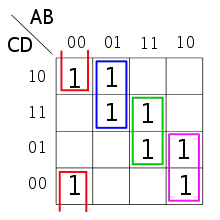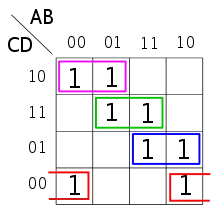Disjunctive normal form
In boolean logic, a disjunctive normal form (DNF) is a canonical normal form of a logical formula consisting of a disjunction of conjunctions; it can also be described as an OR of ANDs, a sum of products, or (in philosophical logic) a cluster concept. As a normal form, it is useful in automated theorem proving.
Definition
A logical formula is considered to be in DNF if it is a disjunction of one or more conjunctions of one or more literals.[1]:153 A DNF formula is in full disjunctive normal form if each of its variables appears exactly once in every conjunction. As in conjunctive normal form (CNF), the only propositional operators in DNF are and (∧), or (∨), and not (¬). The not operator can only be used as part of a literal, which means that it can only precede a propositional variable.
The following is a context-free grammar for DNF:
- disjunction → (conjunction ∨ disjunction)
- disjunction → conjunction
- conjunction → (literal ∧ conjunction)
- conjunction → literal
- literal → ¬variable
- literal → variable
Where variable is any variable.
For example, all of the following formulas are in DNF:
However, the following formulas are not in DNF:
- , since an OR is nested within a NOT
- , since an AND is nested within a NOT
- , since an OR is nested within an AND
The formula is in DNF, but not in full DNF; an equivalent full-DNF version is .
Conversion to DNF


Converting a formula to DNF involves using logical equivalences, such as double negation elimination, De Morgan's laws, and the distributive law.
All logical formulas can be converted into an equivalent disjunctive normal form.[1]:152–153 However, in some cases conversion to DNF can lead to an exponential explosion of the formula. For example, the DNF of a logical formula of the following form has 2n terms:
Any particular Boolean function can be represented by one and only one[note 1] full disjunctive normal form, one of the canonical forms. In contrast, two different plain disjunctive normal forms may denote the same Boolean function, see pictures.
Computational complexity
The Boolean satisfiability problem on conjunctive normal form formulas is NP-hard; by the duality principle, so is the falsifiability problem on DNF formulas. Therefore, it is co-NP-hard to decide if a DNF formula is a tautology.
Variants
An important variation used in the study of computational complexity is k-DNF. A formula is in k-DNF if it is in DNF and each conjunction contains at most k literals.
See also
- Algebraic normal form — other normal forms for logical formulas
- Propositional logic
- Quine–McCluskey algorithm — obtains a minimal DNF for a given Boolean function
- Truth table
Notes
- Ignoring variations based on associativity and commutativity of AND and OR.
References
- B.A. Davey and H.A. Priestley (1990). Introduction to Lattices and Order. Cambridge Mathematical Textbooks. Cambridge University Press.
- David Hilbert; Wilhelm Ackermann (1999). Principles of Mathematical Logic. American Mathematical Soc. ISBN 978-0-8218-2024-7.
- J. Eldon Whitesitt (24 May 2012). Boolean Algebra and Its Applications. Courier Corporation. ISBN 978-0-486-15816-7.
- Colin Howson (11 October 2005). Logic with Trees: An Introduction to Symbolic Logic. Routledge. ISBN 978-1-134-78550-6.
- David Gries; Fred B. Schneider (22 October 1993). A Logical Approach to Discrete Math. Springer Science & Business Media. pp. 67–. ISBN 978-0-387-94115-8.
External links
- "Disjunctive normal form", Encyclopedia of Mathematics, EMS Press, 2001 [1994]
